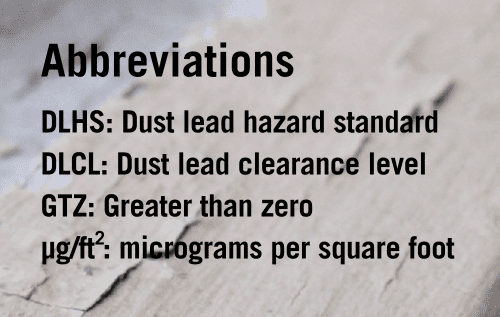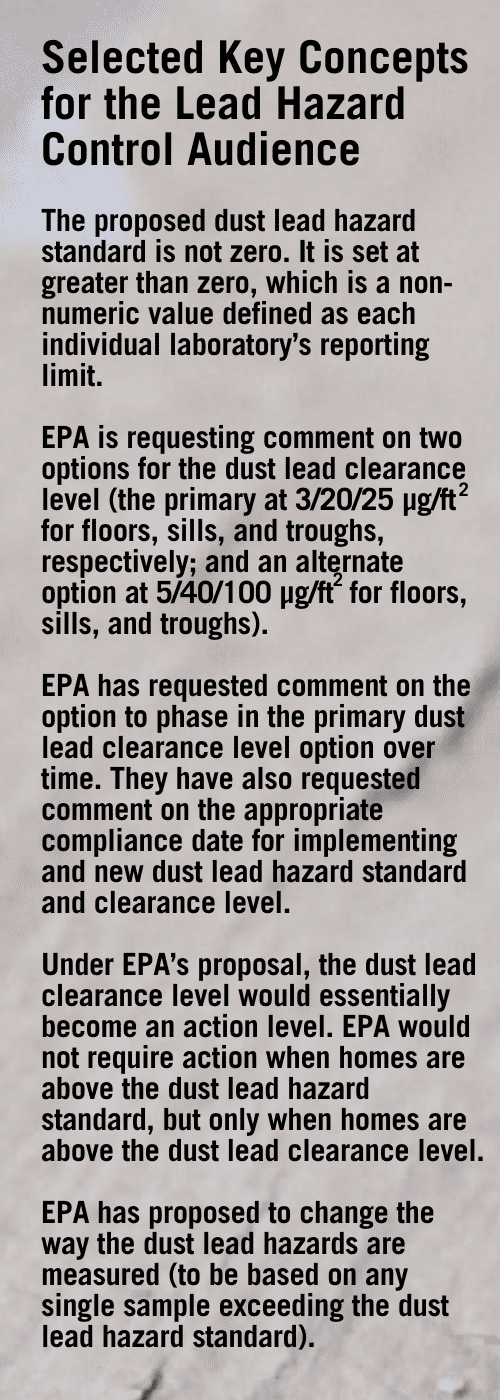An Overview of EPA’s Proposed Changes to the Dust Lead Hazard Standards and Dust Lead Clearance Levels
by Amanda Reddy and Jonathan Wilson
Update: The Federal Register notice was posted on 8/1/2023. This blog was developed based on NCHH’s review of the pre-publication copy of the proposed rule. The Federal Register notice may be accessed online at https://www.federalregister.gov/d/2023-15073/p-220.
 Last week, in an ongoing effort to protect our nation’s children from preventable lead exposure, the Environmental Protection Agency (EPA) proposed changing the dust lead hazard standard (DLHS) and dust lead clearance level (DLCL) for lead dust on floors, windowsills, and window troughs. These changes would define any reportable level of lead dust as a hazard and significantly lower the amount of lead dust allowed after remediation efforts. Per EPA’s July 12, 2023, press release:
Last week, in an ongoing effort to protect our nation’s children from preventable lead exposure, the Environmental Protection Agency (EPA) proposed changing the dust lead hazard standard (DLHS) and dust lead clearance level (DLCL) for lead dust on floors, windowsills, and window troughs. These changes would define any reportable level of lead dust as a hazard and significantly lower the amount of lead dust allowed after remediation efforts. Per EPA’s July 12, 2023, press release:
Today’s proposal would reduce the DLHS from 10 micrograms per square foot (µg/ft2) for floors and 100 µg/ft2 for window sills to any reportable level greater than zero in recognition of the fact that there is no level of lead in dust that has been found to be safe for children. Today’s proposal would lower the DLCL from 10 µg/ft2 to 3 µg/ft2 for floors, from 100 µg/ft2 to 20 µg/ft2 for window sills, and from 400 µg/ft2 to 25 µg/ft2 for window troughs, which are the lowest post-abatement dust-lead levels that the Agency believes can be reliably and effectively achieved.
 NCHH has reviewed the prepublication copy of the proposed rule (available at https://www.epa.gov/system/files/documents/2023-07/PrePubCopy_8524-01_DLHS-DLCL_NPRM_FR_Doc_eSignature_ADMIN_2023-07-12.pdf). Below is our current understanding of what the proposed rule says about many of the questions people are asking in the field. Note that this reflects NCHH’s current understanding of what we have read in the pre-publication copy and is not an official statement. We will update this blog as we refine our understanding of what is in the proposed rule and any other supporting documents published (e.g., technical support document, economic analysis) with the proposed rule.
NCHH has reviewed the prepublication copy of the proposed rule (available at https://www.epa.gov/system/files/documents/2023-07/PrePubCopy_8524-01_DLHS-DLCL_NPRM_FR_Doc_eSignature_ADMIN_2023-07-12.pdf). Below is our current understanding of what the proposed rule says about many of the questions people are asking in the field. Note that this reflects NCHH’s current understanding of what we have read in the pre-publication copy and is not an official statement. We will update this blog as we refine our understanding of what is in the proposed rule and any other supporting documents published (e.g., technical support document, economic analysis) with the proposed rule.
What is the current dust lead hazard standard and dust lead clearance level?
The current dust lead hazard standard for floors is 10 µg/ft2. The DLHS for windowsills is 100 µg/ft2. There is no separate hazard standard for window troughs.
The current dust lead clearance level is 10 µg/ft2 for floors, 100 µg/ft2 for windowsills, and 400 µg/ft2 to for window troughs. (See https://www.epa.gov/lead/hazard-standards-and-clearance-levels-lead-paint-dust-and-soil-tsca-sections-402-and-403.)
What is EPA proposing for the new dust lead hazard standard and dust lead clearance level?
EPA is proposing to reduce the dust lead hazard standard for floors and sills to any reportable level greater than zero. EPA has proposed two different scenarios for the dust lead clearance level. Their primary option proposes to reduce the dust lead clearance level from 10 µg/ft2 to 3 µg/ft2 for floors, from 100 µg/ft2 to 20 µg/ft2 for windowsills, and from 400 µg/ft2 to 25 µg/ft2 for window troughs. These are the lowest post-abatement dust lead levels that the agency believes are feasible. However, they have also asked for comment on an alternative DLCL option. The alternative DLCL that EPA is proposing is to reduce the dust lead clearance level from 10 µg/ft2 to 5 µg/ft2 for floors, from 100 µg/ft2 to 40 µg/ft2 for windowsills, and from 400 µg/ft2 to 100 µg/ft2 for window troughs. Finally, EPA has also asked for comment on the possibility of a phased approach of starting with the alternative DLCL and then lowering it to the primary DLCL at a future specified date.
The alternative DLCL is referenced throughout the proposed rule, including on page 8 of the prepublication copy. The phased approach for the DLCL is discussed on page 120.
Is the new dust lead hazard standard zero?
No. EPA has proposed that the new dust lead hazard standard be greater than zero (GTZ). Per EPA’s proposal, this is not a numeric value. It is set at greater than zero, using the reportable level for an individual laboratory, defined as the lowest level at which laboratories can reliably report results. Per pages 45 and 61 of the pre-publication copy of the proposed rule, labs must have the ability to detect dust lead levels at 50% of the DLCL that is adopted. In other words, if the DLCL is adopted at 3 µg/ft2, labs would need to demonstrate an ability to detect levels of 1.5 µg/ft2. If it is set at 5 µg/ft2, labs would be required to demonstrate a quantitation limit of 2.5 µg/ft2 (see page 61 of the pre-publication copy). Regardless, labs would be required to report at the lowest level that they can reliably report results.
What does “greater than zero” mean in the context of the proposed rule?
Per EPA’s proposal, greater than zero (GTZ) is not a numeric value. GTZ is the reportable level for an individual laboratory, defined as the lowest level at which laboratories can reliably report results. As noted in our answer to the previous question, EPA has set an expectation that labs are reliably able to report at levels that are 50% of the dust lead clearance level (see pages 45 and 61 of the prepublication copy for a discussion of this). You can find EPA’s proposed definition of reportable level and a discussion of the GTZ on pages 38-39 of the prepublication copy.
What does EPA mean by reportable level? Don’t labs have different detection limits?
Yes, labs do have different detection limits. Labs would have to be able to demonstrate that their detection limit is at least 50% of the DLCL, but some labs may be able to report results below that number. You can find EPA’s proposed definition of reportable level and a discussion of the GTZ in several places, including on pages 38-39, 45, and 61 of the pre-publication copy.
Doesn’t this mean that whether a home is above or below the DLHS will depend, in part, on what lab the samples are sent to and what their reporting limit is?
Yes.
Is anything else changing about how the dust lead hazard standard or dust lead clearance level is measured?
Yes. On page 142 of the prepublication copy of the proposed rule, EPA proposes that on or after 12 months after the final rule is published, the dust lead hazard standard will be based on any single sample exceeding the DLHS. Currently, a dust lead hazard is considered present when the weighted arithmetic mean loading for all single-surface or composite samples is greater than the DLHS. The dust lead clearance level currently uses the single-sample approach, and, per our preliminary review, EPA is not proposing to change that; but it does have implications for how many homes will be above each of these levels.
Doesn’t this mean that all older homes will now technically have lead hazards?
This question is difficult to answer based on the available information (either in the pre-publication copy of the proposed rule or in likely data sources like the AHHS II lead report). We anticipate that the Technical Support Document, when available, may provide a clearer understanding of EPA’s expectation of the impact.
Does this mean that all homes above the reporting limit will have lead hazards?
Yes. As currently proposed by EPA, all homes at or above the reporting limits would have lead hazards. Note: NCHH will likely recommend that EPA modify the terminology and replace the term “dust lead hazard standard” with an alternate term, such as “disclosure level” or “lead-contaminated dust level.” This value could be reported along with a standard statement affirming that there is no known safe level of lead exposure. Combined with EPA’s action level approach (see below), this would communicate to property owners and families whether lead has been detected and whether their home is above the threshold for action.
Does this mean that all homes above the reporting limit will be prioritized for remediation?
No. EPA has proposed to redefine the term “abatement” so that action is not required at the dust lead hazard standard level but is required when dust lead loadings are at or above the clearance level. In effect, the clearance level, or DLCL, would become like an action level. If a DLCL of 5 µg/ft2 is adopted, only homes at or above 5 µg/ft2 would be prioritized for remediation. This concept is discussed in multiple places throughout the pre-publication document, including on the bottom of page 71: “[T]he Agency is proposing to change the regulatory definition of abatement so that the recommendation for action applies when dust-lead loadings are at or above the DLCL.” EPA also notes that this is intended to avoid a cyclical pattern where an abatement successfully passes clearance, but an abatement is still recommended.
How many homes have lead dust above EPA’s proposed action level? For instance, if EPA were to adopt 5 µg/ft2 as the new dust lead clearance level (which will also serve as the trigger for action to remediate lead dust hazards), how many homes would we expect to be at or above 5 µg/ft2?
Unfortunately, the AHHS II lead report doesn’t answer this question directly. However, here are a few pieces of information we do have:
- A significant portion of homes in the country (more than half) are statutorily exempt from dust lead reporting. This includes homes built after 1977, senior housing, and zero-bedroom units not occupied by children.
- According to the AHHS II lead report:
- About 35% (20.9 million) pre-1978 homes would have actionable floor dust lead if the DLCL/action level is set at 5 µg/ft2 (identified by any single sample).
- About 24% (14.4 million) pre-1978 homes would have actionable sill dust lead levels if the DLCL/action level is set at 50 µg/ft2 (identified by any single sample). Note that EPA is actually proposing 40 µg/ft2 in the alternative DLCL option, but AHHS II doesn’t report comparable information at that level.
- There would likely be significant, but not complete, overlap between homes with floor dust lead hazards and window dust lead hazards (e.g., it doesn’t necessarily make sense to add these two numbers to estimate the number of homes that would be identified as having ACTIONABLE dust lead hazards under the proposed rule).
- Some portion (likely a significant portion) of these homes would already be identified as having a lead-based paint hazard based on the presence of deteriorating lead-based paint.
- As detailed in the AHHS II lead report, a higher percentage of older homes (particularly those built prior to 1940), homes in the Northeast and Midwest, and lower-income homes are likely to have dust lead hazards, so even a rough approximation of the percentage of homes that would be actionable under the proposed rule is likely to vary widely between communities (not only due to older housing but also to higher background levels in some communities.
Doesn’t this mean that a home can clear but still legally have lead hazards?
Yes. As proposed, a home could pass clearance and still legally have lead hazards. EPA addresses this concern on page 71 of the prepublication copy of the proposed rule and asks for comment on proposed language to be added to the abatement report.
Note: For this reason, NCHH will likely propose that EPA consider using the term “disclosure level” or “lead-contaminated dust level” in place of “dust lead hazard standard” (DLHS) going forward. This may reduce confusion with how the DLHS has been historically used and increase consistency with terminology across sources of exposure. It may also assist with providing clearer messaging to families, property owners, and other stakeholders. For instance, it would help to avoid situations such as when post-clearance levels were below the DLCL, but families were still told they had hazards. The term “disclosure level” could help explain to families with post-clearance levels above the proposed DLHS and below the DLCL that lead still exists in their environment but that the levels are below the threshold recommended for action. This provides families with the most complete information and choice of how and when to act or seek assistance.
When will all of this go into effect?
EPA is likely to open the comment period for 60 days, then will take time to review comments before issuing a final rule. EPA is proposing (page 87) that the rule go into effect 60 days after publication of the final rulemaking in the Federal Register and has also proposed an extended compliance date for one year after that (e.g., if the final rule were to go into effect in July 2024, the compliance date could be set for July 2025). EPA is requesting comment on what compliance date is appropriate.
Can contractors even achieve clearance at 5 µg/ft2? Won’t this make their jobs harder?
This is an area of great debate. EPA presents their analysis in the proposed rule (see, for instance, pages 64 and 68 of the prepublication copy) and has ascertained that these levels are attainable. NCHH’s own research suggests that under some circumstances, it is possible to achieve clearance but not necessarily sustain levels below 5 µg/ft2. It is also important to note that there are many factors that influence how easy or difficult it may be to clear at 5 µg/ft2, including the type and location of the housing and that the need for additional cleaning and challenges of sustaining low levels of dust lead over time has implications for both EPA’s estimated costs and benefits.
NCHH anticipates that EPA will receive feedback from contractors with substantial concerns about the feasibility of achieving the proposed DLCL. Many communities working to reduce lead exposure already face significant contractor shortages that impede their progress, and there is the potential for the proposed rule to exacerbate those challenges. We plan to urge EPA to work with federal partners on ways to address these concerns (e.g., can other federal programs promulgate separate guidance that might phase the DLCL in over a longer period? Would EPA adding a longer transition period [or perhaps a more incremental first step] in their proposed phased approach to implementing the DLCL address contractor capacity concerns?).
What will this cost?
EPA estimates costs in multiple places including on pages 13 and 15 of the prepublication copy of the proposed rule. EPA has also explicitly asked for comment on their estimated costs.
How can I tell EPA what I think about the proposed rule?
EPA will be accepting public comments on docket EPA-HQ-OPPT-2023-0231. Comments must be received on or before October 2, 2023, through the Federal eRulemaking Portal at https://www.regulations.gov. Instructions on how to submit comments are described on the first page of the Federal Register notice. NCHH encourages a wide range of stakeholders to weigh in on this proposed rule. [Updated August 1, 2023.]
An Update to This Blog (October 2023)
On October 2, 2023, NCHH, joined by the Children’s Environmental Health Network (CEHN), Environmental Defense Fund (EDF), and Women for a Healthy Environment (WHE), submitted comments to EPA on the proposed rule. NCHH appreciates the time that so many communities, stakeholders, and experts spent with us over the last several months to help us deepen our understanding of the potential impacts, opportunities, and challenges of EPA’s proposal. Read the comments here.
1 For example, in EPA’s work to reduce lead hazards in drinking water, the maximum contaminant level goal (MCLG), a nonenforceable health goal, is set at zero and the lead action level is set at 15 parts per billion (ppb).
 Amanda Reddy, MS, Executive Director of the National Center for Healthy Housing, has advanced numerous initiatives, including those related to healthcare financing of healthy homes services, training and technical assistance to support the launch and growth of sustainable healthy homes programs, and the development of indicators for the HUD Healthy Communities Index. Prior to NCHH, Ms. Reddy was a research scientist with the New York State Department of Health, where she provided program evaluation, management, and technical support for the Asthma Control, Healthy Homes and Lead Poisoning Primary Prevention, Healthy Neighborhoods, and Healthy Home Environments for New Yorkers with Asthma programs. Ms. Reddy holds an MS in environmental health from the London School of Hygiene and Tropical Medicine and a BA in neuroscience from Mount Holyoke College.
Amanda Reddy, MS, Executive Director of the National Center for Healthy Housing, has advanced numerous initiatives, including those related to healthcare financing of healthy homes services, training and technical assistance to support the launch and growth of sustainable healthy homes programs, and the development of indicators for the HUD Healthy Communities Index. Prior to NCHH, Ms. Reddy was a research scientist with the New York State Department of Health, where she provided program evaluation, management, and technical support for the Asthma Control, Healthy Homes and Lead Poisoning Primary Prevention, Healthy Neighborhoods, and Healthy Home Environments for New Yorkers with Asthma programs. Ms. Reddy holds an MS in environmental health from the London School of Hygiene and Tropical Medicine and a BA in neuroscience from Mount Holyoke College.
 Jonathan Wilson, MPP, joined NCHH in 1993 and currently serves as Deputy Director and Chief Financial Officer. Mr. Wilson has authored more than 25 peer-reviewed research manuscripts evaluating assessment tools and interventions for healthy housing hazards. He also served as the NCHH representative to the federal Advisory Committee on Childhood Lead Poisoning Prevention from 2004 to 2010. He came to NCHH with a background in nonprofit housing development and a Master of Public Policy degree.
Jonathan Wilson, MPP, joined NCHH in 1993 and currently serves as Deputy Director and Chief Financial Officer. Mr. Wilson has authored more than 25 peer-reviewed research manuscripts evaluating assessment tools and interventions for healthy housing hazards. He also served as the NCHH representative to the federal Advisory Committee on Childhood Lead Poisoning Prevention from 2004 to 2010. He came to NCHH with a background in nonprofit housing development and a Master of Public Policy degree.
